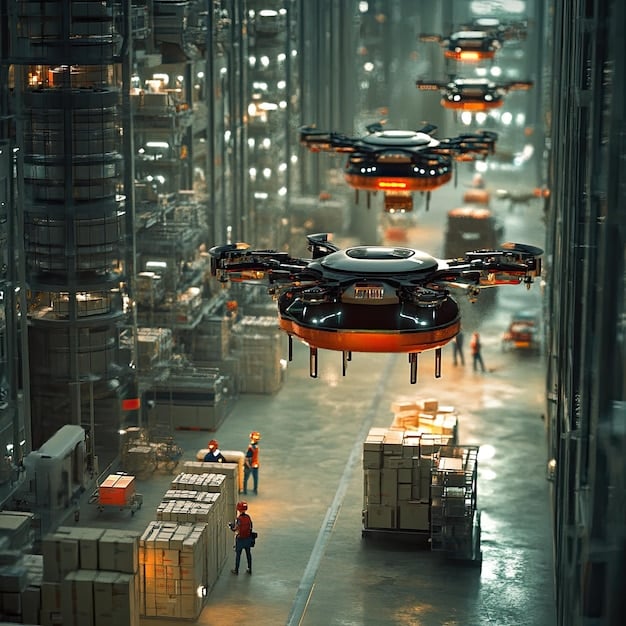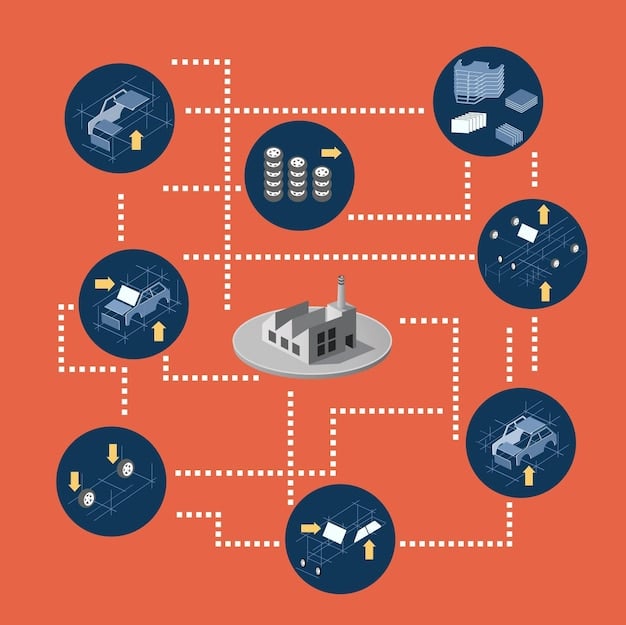The Future of Military Logistics: Autonomous Supply Chains

The Future of Military Logistics: Exploring the Potential of Autonomous Supply Chains focuses on how autonomous systems and technologies are revolutionizing military supply chains, enhancing efficiency and resilience in diverse operational environments.
The landscape of military operations is undergoing a significant transformation, driven by technological advancements that promise to redefine efficiency, speed, and resilience. Among these innovations, the concept of autonomous supply chains stands out as a game-changer. The **future of military logistics: exploring the potential of autonomous supply chains** is not merely a theoretical exercise; it’s a rapidly evolving reality with profound implications for national security and strategic advantage. In this article, we delve deep into how autonomous systems are set to revolutionize military logistics, examining the technologies, benefits, challenges, and future prospects of this transformative trend.
Understanding Autonomous Supply Chains in Military Logistics
Autonomous supply chains represent a paradigm shift in how the military manages the movement of resources, equipment, and personnel. By integrating advanced technologies, these systems aim to create a self-regulating network that minimizes human intervention and maximizes operational effectiveness.
Key Components of Autonomous Military Supply Chains
Several key components form the backbone of autonomous military supply chains, each playing a crucial role in ensuring seamless and efficient operations.
- Robotics and Automation: Automated vehicles, drones, and robotic systems handle transportation, warehousing, and distribution tasks.
- AI and Machine Learning: These technologies enable predictive analytics, demand forecasting, and adaptive decision-making.
- Internet of Things (IoT): IoT devices provide real-time data on inventory, location, and environmental conditions, enhancing visibility and control.
- Blockchain Technology: Blockchain ensures secure and transparent transactions, reducing the risk of fraud and enhancing trust among stakeholders.
The integration of these technologies promises to create a logistics ecosystem that is not only more efficient but also more resilient and adaptable to the dynamic demands of modern warfare.

The Benefits of Autonomous Logistics in Military Operations
The adoption of autonomous supply chains in military operations offers a multitude of benefits, ranging from cost savings to enhanced operational capabilities. These advantages are compelling reasons for the increasing interest and investment in this field.
Increased Efficiency and Speed
Autonomous systems can operate 24/7 without the need for rest or breaks, significantly accelerating the pace of logistics operations. Automated processes reduce the likelihood of human error, leading to more accurate and reliable deliveries.
Reduced Costs and Resource Consumption
By optimizing routes, minimizing waste, and reducing the need for manual labor, autonomous supply chains can substantially lower operating costs. These systems also promote more efficient use of resources, such as fuel and energy, contributing to environmental sustainability.
Enhanced Resilience and Adaptability
Autonomous systems are designed to adapt to changing conditions and unexpected disruptions. They can reroute deliveries, adjust inventory levels, and make real-time decisions to mitigate the impact of unforeseen events, ensuring continuous supply chain operations.
Ultimately, the benefits of autonomous logistics translate to a more agile, cost-effective, and resilient military force capable of responding rapidly to evolving threats and challenges. The **future of military logistics: exploring the potential of autonomous supply chains** offers tangible advantages that are hard to ignore.
Challenges and Obstacles in Implementing Autonomous Military Logistics
While the potential benefits of autonomous military logistics are clear, several challenges and obstacles must be addressed to ensure successful implementation. These hurdles range from technological limitations to regulatory considerations.
Technological Limitations
Despite significant advancements, autonomous systems still face technological limitations, particularly in complex and unstructured environments. Issues such as sensor reliability, data security, and the ability to handle unexpected events require further development and refinement.
Regulatory and Legal Hurdles
The deployment of autonomous systems in military operations raises a host of regulatory and legal questions. Issues such as liability, safety standards, and the use of autonomous weapons systems must be carefully addressed to ensure compliance with international laws and ethical standards.
Integration and Interoperability
Integrating autonomous systems into existing military infrastructure and ensuring interoperability with legacy systems can be a complex and costly undertaking. Standardizing protocols and data formats is essential to facilitate seamless communication and coordination among different systems and stakeholders.

The Role of AI and Machine Learning in Shaping Autonomous Supply Chains
Artificial intelligence (AI) and machine learning (ML) are central to the development of autonomous supply chains. These technologies enable systems to analyze vast amounts of data, make intelligent decisions, and continuously improve their performance.
Predictive Analytics and Demand Forecasting
AI and ML algorithms can analyze historical data, weather patterns, and other relevant factors to predict demand and optimize inventory levels. This capability helps to minimize waste, reduce storage costs, and ensure that supplies are available when and where they are needed.
Adaptive Decision-Making and Optimization
AI-powered systems can make real-time decisions based on changing conditions and unexpected events. They can reroute deliveries to avoid traffic congestion, adjust inventory levels to meet fluctuating demand, and optimize resource allocation to maximize efficiency.
Enhanced Security and Threat Detection
AI and ML can also play a critical role in enhancing the security of autonomous supply chains. These technologies can analyze data to detect anomalies, identify potential threats, and prevent cyberattacks, ensuring the integrity and confidentiality of sensitive information. The **future of military logistics: exploring the potential of autonomous supply chains** is heavily reliant on advancements in AI.
Case Studies and Examples of Autonomous Military Logistics
Several real-world examples demonstrate the potential of autonomous military logistics. These case studies offer insights into how these systems are being used to improve efficiency, reduce costs, and enhance operational capabilities.
Autonomous Drone Deliveries
The use of drones to deliver supplies to remote or inaccessible locations is becoming increasingly common. Drones can transport critical supplies, such as medical equipment, ammunition, and food, quickly and efficiently, even in challenging environments.
Automated Warehousing and Distribution
Automated warehousing systems use robots and AI to manage inventory, pick orders, and prepare shipments. These systems can operate 24/7, significantly increasing throughput and reducing the risk of errors.
Self-Driving Convoys
Self-driving convoys use autonomous vehicles to transport supplies and equipment over long distances. These convoys can reduce the need for human drivers, minimize fuel consumption, and improve safety.
These examples underscore the tangible benefits of autonomous military logistics and highlight the potential for further innovation and adoption in the years to come. The possibilities for **the future of military logistics: exploring the potential of autonomous supply chains** are vast and promising.
Future Trends and Innovations in Autonomous Military Logistics
Looking ahead, several trends and innovations are poised to further transform the landscape of autonomous military logistics. These developments promise to enhance the capabilities of these systems and expand their applicability to a wider range of military operations.
Swarm Robotics
Swarm robotics involves the use of large numbers of small, autonomous robots that work together to achieve a common goal. These robots can be used to perform tasks such as reconnaissance, surveillance, and delivery of supplies.
Additive Manufacturing (3D Printing)
Additive manufacturing, or 3D printing, enables the on-demand production of spare parts, tools, and other equipment. This technology can reduce the need for large inventories and improve the responsiveness of supply chains.
Quantum Computing
Quantum computing has the potential to revolutionize logistics optimization. Quantum algorithms can solve complex optimization problems much faster than classical computers, leading to more efficient routing, scheduling, and resource allocation.
These future trends promise to further enhance the efficiency, resilience, and adaptability of autonomous military logistics, ensuring that military forces remain at the forefront of technological innovation.
| Key Point | Brief Description |
|---|---|
| 🚀 Autonomous Systems | Robotics and automation enhance efficiency in military operations. |
| 🤖 AI & Machine Learning | Enable predictive analytics and real-time decision-making. |
| 🛡️ Enhanced Resilience | Autonomous supply chains adapt to disruptions and ensure continuity. |
| 🌐 IoT Integration | Real-time data on inventory and conditions improves control. |
Frequently Asked Questions
Autonomous supply chains offer increased efficiency, reduced costs, enhanced resilience, and improved adaptability to dynamic operational demands. These benefits contribute to a more agile and effective military force. The **future of military logistics: exploring the potential of autonomous supply chains** highlights these advantages.
Key technologies include robotics and automation, artificial intelligence (AI), machine learning (ML), the Internet of Things (IoT), and blockchain technology. These components enable predictive analytics, real-time monitoring, and secure transactions.
Challenges include technological limitations, regulatory and legal hurdles, and integration and interoperability issues. Addressing these challenges is crucial for ensuring the successful deployment of autonomous systems in military operations.
AI and ML enhance predictive analytics, enable adaptive decision-making, and improve security and threat detection. These technologies optimize resource allocation and ensure that supplies are available when needed.
Future trends include swarm robotics, additive manufacturing (3D printing), and quantum computing. These innovations will further enhance the efficiency, resilience, and adaptability of autonomous military logistics, improving overall military capabilities.
Conclusion
In conclusion, **the future of military logistics: exploring the potential of autonomous supply chains** represents a transformative shift with far-reaching implications for national security and strategic advantage. As technology continues to advance, the adoption of autonomous systems will become increasingly critical for maintaining a competitive edge in the modern battlespace.





